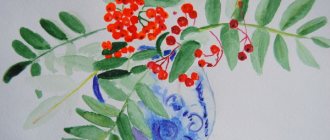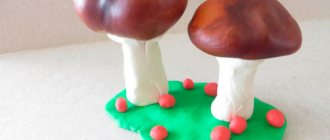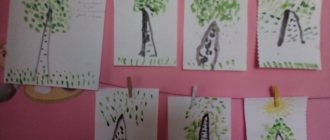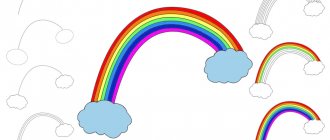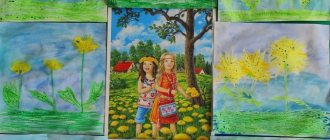Outline of a lesson on decorative drawing on the topic: “Fairytale tree”
Students:
Because the oak has a thick trunk and thick branches, and the crown of the tree looks like a cap, and the birch has a thin trunk and an elongated crown, these trees also differ in color.
Teacher:
Well done, you were very attentive! And now I’ll show you where to start drawing, everyone should come up with their own tree, and a short story about it.
Explanation and demonstration of an algorithm for constructing a tree that does not exist in nature. Practical work (developing a sketch in pencil and filling in color).
You have seen that a simple tree can be turned into an extraordinary one using various objects. Demonstration of student work completed previously. Let's think about what other objects around us can be used when inventing trees.
Students:
Vegetables, fruits, insects, animals, household items, etc.
Teacher:
How many items can be used for a miracle tree! All trees will turn out different, but the principle of their construction will be the same.
We determine the height of the future (planned) tree. Draw a trunk. To do this, find the middle on sheet A3 and draw a vertical line from bottom to top. We leave space at the top and bottom of the sheet, as required by the rules for constructing a composition. You can replace the tree trunk with a planned object, for example, a boot. We draw the main branches to the trunk-boot. Then additional branches, and instead of leaves on them we draw various shoes or other household items: slippers, boots, hats, balls, toys, dishes, etc., whatever you have in mind. Please note that additional branches can be different in shape, length, thickness, color, and decorated in different ways.
Now we design the crown of the tree, if it is oak, then it will be round in shape, if it is birch, then the crown will look like an elongated oval.
Well, we’ve finished the pencil drawing, what are we going to do now?
Students:
We use an eraser to remove all auxiliary lines and draw in color.
Methodological recommendations: the teacher reminds that the drawing should begin with the tree trunk, then the crown, main and additional branches, and objects on the branches. Reminds them of the principle of mixing colors to get what they want, and also draws attention to the fact that they independently, based on their design, select the color scheme. You can remind students that all practical work is divided into two main stages - a pencil sketch and color filling, and recall the rules for working with water and paints.
Teacher:
Now think a little about what kind of tree you will depict and start drawing.
Independent work. (60 min.)
Students work independently. And in order to make your work more fun and get you in the mood to fantasize, music will sound quietly.
Development of middle-aged children by means of drawing
At the age of 4–5 years, preschoolers begin to form an aesthetic attitude towards the world, they begin to understand the beauty of natural phenomena, interiors, and exteriors. At this stage of development, both the teacher and parents must cultivate artistic taste, introduce them to art, teach them not only to look at illustrations, paintings, sculptures, and their own works, but also to evaluate them from the position of correctly conveying the form, color palette, mood, and characteristic features.
Organization of a drawing training system
There must be continuity in the education system. This means that before starting to draw or sculpt any objects, children must have basic knowledge about them, which they receive in classes to familiarize themselves with the outside world, on walks while observing natural phenomena (snow, rain, dew , wind) and objects (soil, trees, flowers, herbs, birds, insects). Thus, previously acquired knowledge will help children better convey the image, its features, and character. In addition, visual activities contribute to the development of artistic taste and skill, harmoniously developing the child’s personality.
In middle preschool age, children take their first steps in composing and thinking through a composition. First, the teacher offers different options for plot compositions, gradually introducing individual elements into the children’s work that would decorate the image and create the integrity of the image. In the process of acquiring the skill of composing a composition, children begin to independently arrange parts of the drawing, applications on a sheet of paper, and think through details that could decorate their work. All this develops the imagination and creative thinking of children.
Drawing techniques and additional types of visual activities
In drawing classes, you can use traditional drawing techniques using colored pencils, wax crayons, gouache, and watercolors. You can combine drawing media: watercolor and wax crayons. Among the non-traditional techniques, finger painting, blotography, and poking may be interesting.
The theme “Fairytale Tree” allows you to develop interest in various types of visual activities, that is, along with drawing, the teacher can use modeling, for example, on the theme “Gifts of the Fairytale Tree”, and application on the theme “What fairy tale is our tree from?”, “On fruits and vegetables grew on the fairy tree.” Much also depends on the imagination of the teacher, because only a person with a rich inner world and a pedagogical spark can captivate children into the world of creativity and teach them to create.
The teacher can offer individual tasks to children who show special interest and ability in drawing. For example, draw a fairy-tale tree with unusual fruits, using non-traditional drawing techniques (stamping, finger painting), with colorful leaves (color prints of natural leaves of trees or shrubs). Children should find the idea of using semolina when suddenly such a tree has grown in a fairy-tale winter forest, or colored sand, with the help of which they can add texture to the gifts of a fairy-tale tree. This kind of assignment turns a learning session into a real creative process, and the children feel like artists.
Themes of collective and individual compositions
The topic of drawing a fairy-tale tree is studied after mastering the drawing topics “Draw a picture about summer”, “Apples are ripe on the apple tree”, “Beautiful flowers”, modeling “Apples and berries”, “Big and small carrots”, “Vegetables and fruits”. Thus, children already have an idea of how to depict a tree, various vegetables and fruits, berries that can be the fruits of a fairy-tale tree. In thematic planning, the topic under discussion is scheduled for October, that is, the beginning of the school year. Children are not yet ready for complex compositional solutions. The teacher may suggest drawing some fabulous details, for example, grass, flowers of unusual colors and shapes. However, at the end of the year, when children already master various brush painting techniques, including non-traditional drawing techniques, we can talk about complicating the plot and compositional lines.
Examples include the following ideas:
- “The Magic Garden”, where apple trees with golden apples grow and flowers of extraordinary beauty bloom. You can use the finger painting technique to depict apples.
- “Birds of Paradise” - in the center of a large sheet of paper there is a tree drawn on which children place drawn and cut out fairy birds.
- "Visiting a fairy tale." Drawing based on the fairy tale “12 months”. In a fabulous winter forest, flowers bloomed and trees blossomed in an instant. You can work in small subgroups with individual tasks.
- "Fairytale tree from children's palms." A tree is drawn in the center of the sheet; children use multi-colored handprints to depict miracle leaves.
- “How gifts grew on our Christmas tree.” Children draw and cut out gifts (toys, boxes with bows, sweets, tangerines), then place them on the tree drawn by the teacher.
Game motivation
At the beginning of the lesson, the teacher devotes several minutes to activating the cognitive activity of children, using various gaming techniques. By combining the rich world of play with the educational process, the teacher makes completing any task interesting. Thus, children should have play motivation. As a motivating start, you can use reading K. Chukovsky’s poem “The Miracle Tree” with showing illustrations, talking with children about which tree is called fairy-tale and why. In addition, pedagogical ingenuity and imagination can help the teacher himself come up with a fairy tale about a magical garden or a fairy-tale forest. The teacher and the children can fantasize about what unusual things can grow on fairy-tale trees.
Practical tips for making notes for a drawing lesson in the middle group
When drawing up lesson notes, you need to pay attention to the sequence and types of work that are planned to be involved and correctly allocate time for each educational stage:
- Preliminary work (2–3 minutes)
- Main part (10–13 minutes)
- Physical education minute (1–2 minutes)
- Final part (summarizing) (2 minutes)

